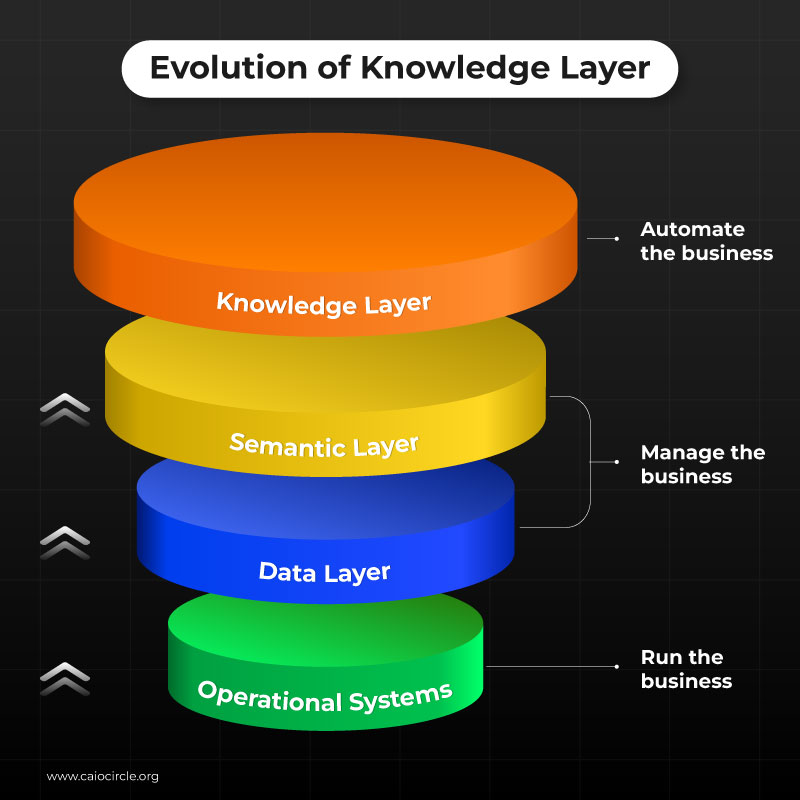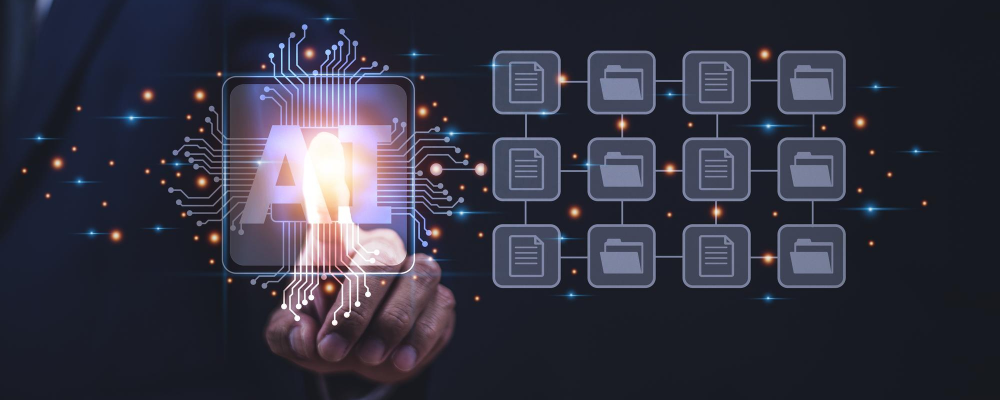

In today’s rapidly evolving digital landscape, organizations are seeking ways to shift from reactive operations to proactive, intelligent automation. The foundation of this evolution lies in how businesses manage, interpret, and act upon their data. The diagram titled “Evolution to Knowledge Layer†illustrates a strategic progression of enterprise data architecture—from basic operations to AI-driven intelligence—framed across four key layers: Operational Systems, Data Layer, Semantic Layer, and the transformative Knowledge Layer. Each tier plays a pivotal role in how businesses run, manage, and automate their operations, with the Knowledge Layer representing the pinnacle of AI-driven transformation.

This article explores the evolution of Knowledge Layer, and how it is becoming a game changer in taking businesses to the world of automation.
At the base of the architecture lie the Operational Systems, where day-to-day business processes are executed. These systems—such as ERP, CRM, supply chain, and HR platforms—generate transactional data that reflects the pulse of the enterprise. While critical for business continuity, the data at this stage is raw, fragmented, and often siloed, limiting its use for strategic insight.
The Data Layer captures and consolidates this operational data, enabling storage, querying, and basic reporting. Here, data lakes, warehouses, and streaming platforms transform raw inputs into structured formats. This layer lays the technical groundwork for analytics and insights. However, it still lacks business context and remains challenging for non-technical stakeholders to interpret meaningfully.
The Semantic Layer adds meaning to the structured data by contextualizing it within the business domain. By introducing business-friendly terminology, data models, and relationships, it allows users to interact with information through a more intuitive lens. This is where dashboards, KPIs, and BI tools come into play, empowering decision-makers to manage the business based on trusted, consistent insights.
Yet, despite these advances, a significant challenge remains: human dependence. Even with robust data and semantic layers, decision-making is still heavily reliant on human interpretation—a costly and time-consuming “human-in-the-loop†process.
Enter the Knowledge Layer—the apex of this evolution. Powered by Large Language Models (LLMs) and advanced AI techniques, this layer acts as a centralized intelligence fabric across the enterprise. It synthesizes structured data and domain knowledge into actionable insights, enabling:
- Predictive capabilities that anticipate trends and outcomes
- Generative AI for content creation, scenario modeling, and innovation
- Agentic AI that can take autonomous action based on business rules and objectives
By encapsulating organizational intelligence, the Knowledge Layer eliminates fragmented decision-making and enables scalable automation, transforming how businesses operate. This is the layer that enables the automation of complex tasks such as fraud detection, customer personalization, supply chain optimization, and dynamic pricing.
For example:
- A retail business can use the Knowledge Layer to automatically adjust inventory based on forecasted demand.
- A bank can identify and act on anomalies in transaction data in real time.
- A healthcare system can prioritize patient care based on AI-driven risk assessments.
It’s important to note that AI in the Knowledge Layer is only as powerful as the layers beneath it. Poor data quality in the Data Layer or ambiguous logic in the Semantic Layer can cripple AI’s effectiveness. This is why organizations are investing in end-to-end data governance and semantic modeling before attempting to deploy AI at scale.
The journey from Source Systems to the Knowledge Layer is a journey from data collection to insight generation to business automation. While humans still manage and monitor many processes, the goal of AI is to eventually take over high-volume, low-value tasks and support humans in high-value, strategic decisions.
This layered evolution offers a clear path for organizations striving to become intelligent enterprises:
- Run the business efficiently with operational systems
- Manage the business with a trusted semantic foundation
- Automate the business through AI-powered knowledge synthesis
Organizations that successfully adopt and integrate a Knowledge Layer will unlock new levels of agility, responsiveness, and innovation—turning data into a true strategic asset.
The Knowledge Layer represents the intelligent core of a modern AI-powered enterprise. By building upon robust data and semantic foundations, this layer enables organizations to not just understand what is happening, but to predict and act on what will happen next. As AI continues to evolve, the Knowledge Layer will become increasingly central to automating complex business operations and driving innovation.
In the second article of this series, we will take a deep dive into the Knowledge Layer, exploring how a well-designed architecture enables various business functions across the enterprise to collaborate and make seamless, cross-functional decisions—powered by AI agents.


